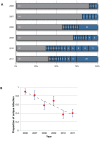Genetic surveillance detects both clonal and epidemic transmission of malaria following enhanced intervention in Senegal
- PMID: 23593309
- PMCID: PMC3617153
- DOI: 10.1371/journal.pone.0060780
Genetic surveillance detects both clonal and epidemic transmission of malaria following enhanced intervention in Senegal
Abstract
Using parasite genotyping tools, we screened patients with mild uncomplicated malaria seeking treatment at a clinic in Thiès, Senegal, from 2006 to 2011. We identified a growing frequency of infections caused by genetically identical parasite strains, coincident with increased deployment of malaria control interventions and decreased malaria deaths. Parasite genotypes in some cases persisted clonally across dry seasons. The increase in frequency of genetically identical parasite strains corresponded with decrease in the probability of multiple infections. Further, these observations support evidence of both clonal and epidemic population structures. These data provide the first evidence of a temporal correlation between the appearance of identical parasite types and increased malaria control efforts in Africa, which here included distribution of insecticide treated nets (ITNs), use of rapid diagnostic tests (RDTs) for malaria detection, and deployment of artemisinin combination therapy (ACT). Our results imply that genetic surveillance can be used to evaluate the effectiveness of disease control strategies and assist a rational global malaria eradication campaign.
Conflict of interest statement
Figures



References
-
- World Health Organization (2011) World malaria report 2011. World Health Organization 246.Geneva:
-
- Volkman SK, Sabeti PC, DeCaprio D, Neafsey DE, Schaffner SF, et al. (2007) A genome-wide map of diversity in Plasmodium falciparum. Nat Genet 39: 113–119 doi:10.1038/ng1930. - DOI - PubMed
-
- Mzilahowa T, Mccall PJ, Hastings IM (2007) “Sexual” Population Structure and Genetics of the Malaria Agent P. falciparum. PLoS ONE 2: e613 doi:10.1371/journal.pone.0000613.t001. - DOI - PMC - PubMed
-
- Anderson TJ, Haubold B, Williams JT, Estrada-Franco JG, Richardson L, et al. (2000) Microsatellite markers reveal a spectrum of population structures in the malaria parasite Plasmodium falciparum. Mol Biol Evol 17: 1467–1482. - PubMed
-
- Neafsey DE, Schaffner SF, Volkman SK, Park D, Montgomery P, et al. (2008) Genome-wide SNP genotyping highlights the role of natural selection in Plasmodium falciparum population divergence. Genome Biol 9: R171 doi:10.1186/gb-2008-9-12-r171. - DOI - PMC - PubMed
Publication types
MeSH terms
Grants and funding
LinkOut - more resources
Full Text Sources
Other Literature Sources

